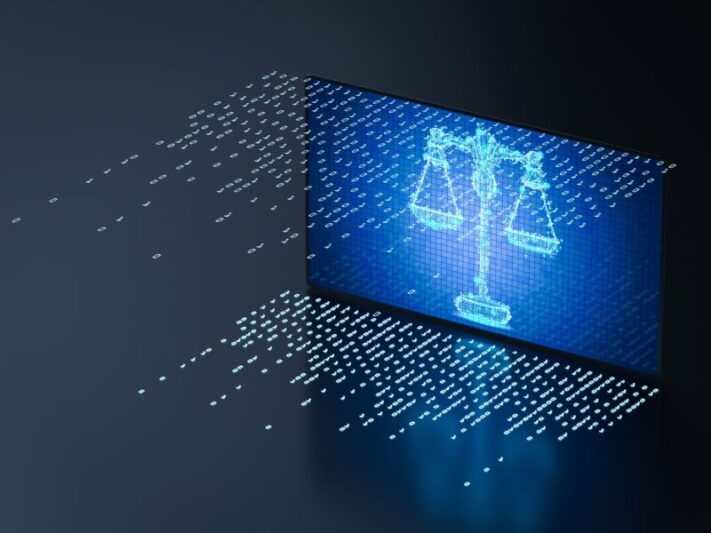The European regulation on artificial intelligence is entering a decisive phase. With the adoption of the AI Act, companies that develop, deploy, or use artificial intelligence systems are now subject to a demanding legal framework. In case of non-compliance, the sanctions provided are in line with the societal, economic, and ethical stakes represented by AI. Here is a clear overview of the risks incurred, whether financial, operational, or reputational, and a spotlight on the lasting consequences of an insufficient compliance strategy.
A strict legal framework: the sanctions provided by the AI Act
Article 99 of the AI Act clearly defines three levels of sanctions in case of violation.
Non-compliance with prohibited AI practices.
Failure to comply with prohibited AI practices may lead to a fine of up to €35 million or up to 7% of the global annual turnover of the previous financial year, whichever is higher for large companies.
Non-compliance with obligations applicable to operators and notified bodies.
In case of non-compliance with obligations applicable to operators or notified bodies, the sanction may reach €15 million or 3% of global turnover.
Providing incorrect, incomplete, or misleading information to competent authorities.
Also, providing incorrect, incomplete, or misleading information to the competent authorities may expose the organization to a fine of up to €7.5 million or 1% of turnover.
For each type of sanction, the threshold will be the highest amount in the case of large companies. For SMEs and start-ups, the lower amounts apply, according to the principle of proportionality included in the regulation.
The indirect effects linked to non-compliance with the AI Act
Financial and operational risks.
Beyond financial sanctions, non-compliance can have an immediate impact on the operational structure of a company. The withdrawal of solutions deemed non-compliant, the need to urgently adapt them, or the costs associated with an in-depth regulatory audit can weaken a business model, especially when these issues are unexpected.
Contractual and market risks.
From a commercial standpoint, many procurement procedures, particularly in public or strategic sectors, now include explicit compliance requirements. A company not aligned with the AI Act is therefore exposed to systematic exclusion from high-potential markets and a net loss of opportunities.
Reputational and business risks.
Reputation is another critical link. A public sanction or negative media coverage can permanently damage a tech actor’s credibility, cool investor interest, and generate lasting hesitation among partners. Even the most promising AI projects can be abruptly halted by a crisis of trust.
Innovation and time-to-market risks.
The consequences also extend to internal dynamics. Delays in the development of new offerings, due to the lack of integration of compliance from the design phase, can disrupt go-to-market timelines. Furthermore, R&D teams often have to reallocate time and budgets to regulatory issues, at the expense of strategic innovations.
Cultural and organizational risks.
Finally, regulatory pressure can deeply alter company culture. Risk aversion increases, limiting experimentation around AI. Tensions may arise between growth imperatives and compliance obligations, weakening organizational agility.
Consequences that go beyond the organization
Public trust in AI
The effects of non-compliance do not stop at the company’s borders. When an incident occurs, whether it’s algorithmic bias or a privacy violation, public distrust toward AI increases. This mistrust is not limited to the involved actor; it spreads across the entire ecosystem, making it harder for even compliant solutions to be adopted.
Once trust is damaged, restoring it requires time, resources, and a level of transparency that few organizations are fully prepared to deliver. The result is market stagnation and collective delay in deploying useful innovations.
The societal impacts are just as concerning. Poorly designed or unvalidated systems can reinforce inequalities in access to employment, credit, or education. Others, poorly controlled, contribute to the spread of extreme or biased content, destabilizing the democratic space. The feeling of a lack of collective control over these tools further amplifies distrust in both public and private institutions.
Finally, individual safety may be directly threatened. In sensitive contexts such as health, justice, or transport, non-compliant AI can lead to unfair or dangerous decisions. The absence of guarantees regarding data protection opens the door to non-consensual surveillance or abusive profiling. Worse, poorly supervised systems can be hijacked for malicious purposes: fake content creation, targeted attacks, automated manipulation.
Compliance with the AI Act cannot be treated as a mere administrative formality. It is a strategic lever to secure operations, strengthen the credibility of AI actors, and contribute to a trustworthy technological environment. Anticipating requirements, integrating compliance from the design stage, and making each stakeholder accountable: these are the foundations of sustainable governance aligned with the challenges of the 21st century.
Need support?
Whether you’re at the beginning of your compliance journey or facing complex decisions, our teams can help you structure your approach, identify risk areas, and build a robust governance strategy tailored to your sector.
